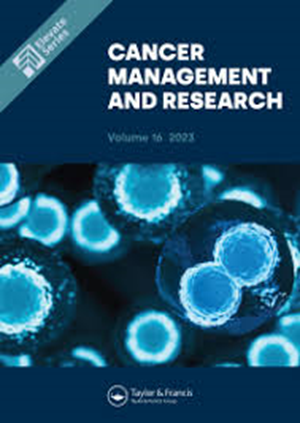Combination Therapy with Immune Checkpoint Inhibitors and Histone Deacetylase Inhibitors or Alkylating Agents
IF 2.5
4区 医学
Q3 ONCOLOGY
引用次数: 0
Abstract
Purpose: Immune checkpoint inhibitors (CPIs) have been widely adopted in a number of early and advanced malignancies. Histone deacetylase inhibitors (HDACis) and alkylating agents (AAs) have been suggested to potentiate the actions of CPIs on tumor cells. We conducted a comprehensive literature review to explore the potential synergistic activity between CPIs, AAs, and HDACis.Patients and Methods: Clinical and non-clinical studies describing outcomes in patients with cancer receiving CPIs and either concomitant or sequential (pre- or post-CPI) AAs or HDACis were identified in PubMed using pre-defined search strings. Manual searches of key oncology congresses were similarly performed. All relevant articles and abstracts were manually screened for relevance, classified according to the specific anticancer agents used (CPIs, AAs, or HDACis), tumor entity, and whether treatment was concomitant or sequential.
Results: Overall, 227 unique clinical studies across a range of tumor types, both solid tumors and hematological malignancies, were identified. One hundred and fifty-nine publications on Phase I and II clinical studies together with 41 publications on Phase III studies were examined. The most commonly investigated tumor types were melanoma, triple-negative breast cancer, non-small cell lung cancer, and Hodgkin lymphoma. The randomized clinical studies identified, all of which reported on the combination of a CPI with an AA, demonstrated superior outcomes in the combination arm compared with CPI or AA monotherapy. Similarly, combination therapy with CPIs and HDACis demonstrated promising activity.
Conclusion: Sequential or concomitant administration of a CPI with an AA or an HDACi may improve outcomes for patients with a range of tumor types. There is a rationale to support further investigation into the potential for synergy between CPIs, alkylating agents and/or HDACis in both the non-clinical and clinical settings.
Plain Language Summary: People being treated for cancer will often receive more than one drug at a time, and the concept of combining cancer drugs is frequently investigated as a potential opportunity to improve outcomes for patients. We reviewed the published literature for clinical trials and work undertaken in laboratories to explore whether combining targeted agents that stop cancer cells from multiplying (known as checkpoint inhibitors) with traditional chemotherapy that kills cancer cells could be a useful approach. We looked at evidence in publications where checkpoint inhibitors were used at the same time as chemotherapy, or given immediately before or after chemotherapy. The most important evidence came from clinical trials where outcomes for patients receiving combinations of treatment were directly compared with those from patients receiving a single treatment. These studies showed superior outcomes for patients who were treated with a combination of cancer drugs compared with patients receiving monotherapy. We also found evidence that adding another class of cancer drug, called histone deacetylase inhibitors, might sensitize tumors to checkpoint inhibitors. These findings provide a rationale for examining alkylating agents and/or histone deacetylase inhibitors combined with checkpoint inhibitors.
Keywords: histone deacetylase inhibitor, checkpoint inhibitor, alkylating agents, synergy, hematological malignancies, solid tumors
免疫检查点抑制剂与组蛋白去乙酰化酶抑制剂或烷基化药物的联合疗法
目的:免疫检查点抑制剂(CPIs)已被广泛用于一些早期和晚期恶性肿瘤。有人认为组蛋白去乙酰化酶抑制剂(HDACis)和烷化剂(AAs)能增强CPIs对肿瘤细胞的作用。我们进行了全面的文献综述,以探索 CPIs、AAs 和 HDACis 之间潜在的协同活性:使用预先定义的搜索字符串,在 PubMed 上查找描述癌症患者接受 CPIs 和同时或先后(CPI 之前或之后)接受 AAs 或 HDACis 治疗的临床和非临床研究。对主要肿瘤学大会也进行了类似的人工检索。人工筛选所有相关文章和摘要的相关性,并根据使用的特定抗癌药物(CPI、AA 或 HDACis)、肿瘤实体以及治疗是同时进行还是连续进行进行进行分类:总体而言,共发现了 227 项独特的临床研究,涉及多种肿瘤类型,包括实体瘤和血液恶性肿瘤。其中 159 篇发表于 I 期和 II 期临床研究,41 篇发表于 III 期研究。最常研究的肿瘤类型是黑色素瘤、三阴性乳腺癌、非小细胞肺癌和霍奇金淋巴瘤。已确定的随机临床研究均报告了 CPI 与 AA 的联合治疗,结果显示联合治疗组的疗效优于 CPI 或 AA 单药治疗组。同样,CPI 与 HDACis 的联合疗法也显示出良好的活性:结论:CPI 与 AA 或 HDACi 相继或同时给药可改善各种肿瘤类型患者的预后。有理由支持在非临床和临床环境中进一步研究 CPIs、烷化剂和/或 HDACis 之间的潜在协同作用。我们回顾了已发表的临床试验文献和实验室工作,以探讨将阻止癌细胞繁殖的靶向药物(称为检查点抑制剂)与杀死癌细胞的传统化疗相结合是否是一种有用的方法。我们研究了在化疗的同时使用检查点抑制剂或在化疗前后立即使用检查点抑制剂的出版物中的证据。最重要的证据来自临床试验,在这些试验中,接受联合治疗的患者的疗效与接受单一治疗的患者的疗效进行了直接比较。这些研究显示,与接受单一疗法的患者相比,接受联合抗癌药物治疗的患者疗效更佳。我们还发现有证据表明,加入另一类抗癌药物(组蛋白去乙酰化酶抑制剂)可能会使肿瘤对检查点抑制剂敏感。这些发现为研究烷化剂和/或组蛋白去乙酰化酶抑制剂与检查点抑制剂联合应用提供了理论依据。 关键词:组蛋白去乙酰化酶抑制剂;检查点抑制剂;烷化剂;协同作用;血液恶性肿瘤;实体瘤
本文章由计算机程序翻译,如有差异,请以英文原文为准。
求助全文
约1分钟内获得全文
求助全文
来源期刊

Cancer Management and Research
Medicine-Oncology
CiteScore
7.40
自引率
0.00%
发文量
448
审稿时长
16 weeks
期刊介绍:
Cancer Management and Research is an international, peer reviewed, open access journal focusing on cancer research and the optimal use of preventative and integrated treatment interventions to achieve improved outcomes, enhanced survival, and quality of life for cancer patients. Specific topics covered in the journal include:
◦Epidemiology, detection and screening
◦Cellular research and biomarkers
◦Identification of biotargets and agents with novel mechanisms of action
◦Optimal clinical use of existing anticancer agents, including combination therapies
◦Radiation and surgery
◦Palliative care
◦Patient adherence, quality of life, satisfaction
The journal welcomes submitted papers covering original research, basic science, clinical & epidemiological studies, reviews & evaluations, guidelines, expert opinion and commentary, and case series that shed novel insights on a disease or disease subtype.
 求助内容:
求助内容: 应助结果提醒方式:
应助结果提醒方式:


